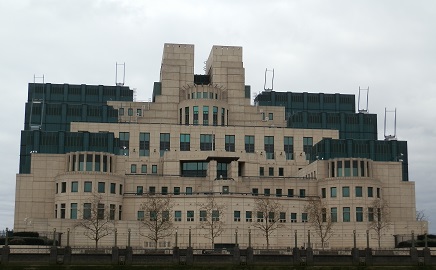SIS Building
Contents |
[edit] Introduction
The Secret Intelligence Services (SIS) Building, more commonly known as the MI6 Building, is the headquarters of the British Secret Intelligence Service, situated on the Albert Embankment section of the River Thames next to Vauxhall Bridge. The building was completed and inaugurated in 1994 and has come to be recognised as one of London's most distinctive structures (the irony of which, for a secret organisation, has been widely commented on).
The building's architect was Terry Farrell, whose Mayan and Aztec temple design translated into a post-modern style was met with criticism and nicknames such as the 'Vauxhall Trollop' and 'Babylon-on-Thames'.
[edit] Design and construction
Security issues prompted the need for a new headquarters for MI6 who had previously occupied an office block near Waterloo Station. In 1983, the Albert Embankment site was purchased by the property developers Regalian Properties plc, who in 1987 approached the Government to assess their interest in such a building being developed for their purposes.
In 1988, the then Prime Minister Margaret Thatcher agreed to the purchase of the new building for the SIS at a cost of £135.05m for the site and £152.6m for the basic building.
The building incorporates modern protection measures, including bomb blast protection, emergency back-up systems, and triple-glazed windows that make use of 25 different types of glass. The ancient temple style of the exterior was an effect created by building up numerous layered blocks, laid out to create 60 separate roof areas.
The building extends considerably below street level, has protective moats and is rumoured to include an underground corridor stretching beneath the Thames to Whitehall.
[edit] Completion
The building was officially opened by Queen Elizabeth II in July 1994. It has since featured prominently in several recent films of the James Bond franchise, including 'The World Is Not Enough' in 1999 when part of the building appeared to be blown up in a terrorist attack and 'Spectre' in 2015 in which it was portrayed as a ruin awaiting demolition.
In 2011 the SIS Building was voted one of the world's 30 ugliest buildings by the Telegraph property team.
[edit] Project data
- Address: 85 Albert Embankment, Vauxhall, Lambeth
- Completed: 1994
- Architect: Terry Farrell and Partners
- Developer: Regalian Properties plc
- Main contractor: John Laing plc
- Owner: HM Government
[edit] Related articles on Designing Buildings Wiki
- 10 Downing Street.
- 33 Thomas Street, New York.
- British Embassies: Their diplomatic and architectural history.
- Building of the week series.
- Buildings in film.
- City Hall, London.
- Concept architectural design.
- El Castillo.
- Farrell Review.
- Leadenhall building.
- Palace of Westminster.
- Tallest buildings in the world.
- The Gherkin.
- The Pentagon.
- The Shard.
- US Air Force CCLD, Colorado.
- US Embassy hotel plans.
- Ziggurat.
Featured articles and news
RTPI leader to become new CIOB Chief Executive Officer
Dr Victoria Hills MRTPI, FICE to take over after Caroline Gumble’s departure.
Social and affordable housing, a long term plan for delivery
The “Delivering a Decade of Renewal for Social and Affordable Housing” strategy sets out future path.
A change to adoptive architecture
Effects of global weather warming on architectural detailing, material choice and human interaction.
The proposed publicly owned and backed subsidiary of Homes England, to facilitate new homes.
How big is the problem and what can we do to mitigate the effects?
Overheating guidance and tools for building designers
A number of cool guides to help with the heat.
The UK's Modern Industrial Strategy: A 10 year plan
Previous consultation criticism, current key elements and general support with some persisting reservations.
Building Safety Regulator reforms
New roles, new staff and a new fast track service pave the way for a single construction regulator.
Architectural Technologist CPDs and Communications
CIAT CPD… and how you can do it!
Cooling centres and cool spaces
Managing extreme heat in cities by directing the public to places for heat stress relief and water sources.
Winter gardens: A brief history and warm variations
Extending the season with glass in different forms and terms.
Restoring Great Yarmouth's Winter Gardens
Transforming one of the least sustainable constructions imaginable.
Construction Skills Mission Board launch sector drive
Newly formed government and industry collaboration set strategy for recruiting an additional 100,000 construction workers a year.
New Architects Code comes into effect in September 2025
ARB Architects Code of Conduct and Practice available with ongoing consultation regarding guidance.
Welsh Skills Body (Medr) launches ambitious plan
The new skills body brings together funding and regulation of tertiary education and research for the devolved nation.
Paul Gandy FCIOB announced as next CIOB President
Former Tilbury Douglas CEO takes helm.
UK Infrastructure: A 10 Year Strategy. In brief with reactions
With the National Infrastructure and Service Transformation Authority (NISTA).























